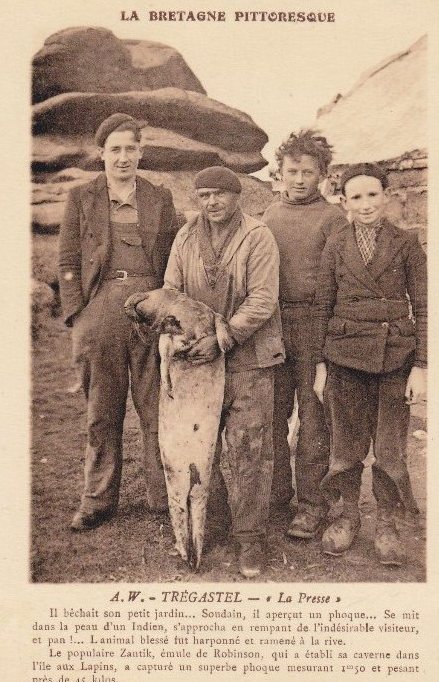Male grey seals weigh between 170 and 310 kilograms and measure between 2.5 and 3.3 meters in length. Females weigh 190 kilograms and measure up to 2 meters. Their coat is a remarkable range of greys, creating different markings which help to identify each individual, making photographical observations much more precise. Facial recognition isn’t just for humans! Thanks to Argos sea beacons, we can track the movement of individuals and learn much more about their biology. Campaigns led by Océanopolis, the ONCFS (France’s hunting and wild animals bureau) and the University of La Rochelle from 1997 to 2002, revealed to us that crossing the Channel is mere child’s play for grey seals in Wales and, in the other direction, seals from Brittany’s Molène archipelago can easily swim to the coasts of Cornwall or Ireland. We also know more about their diving and sleeping patterns thanks to those who have been nursed back to health, or who live in captivity. At night, they sleep on platforms on dry land, whereas in the daytime, they sleep underwater. As if on automatic pilot, they can stay five or six minutes under a rock or attached to kelp which they wedge between their paws, before coming up for air. But it would be wrong to think they fill their lungs to the brim as you would a scuba tank. In fact, it’s by decreasing the air volume that they are able to control their dives. Finally, autopsies have helped us to understand their diet more precisely. Breton seals mainly eat coastal fish varieties, such as mullet, plaice and wrasse, as well as cephalopods and sometimes even seabirds.
An early weaning process
As black clouds swirl above them, mother seals on the Brittany coast give birth to their pure white pups. The pupping season for these grey seals lasts from November through to January. The mothers settle themselves on little rocky outcrops where they will feed their pups for three weeks, by the end of which the pups will have moulted and give themselves up to the waves, victims of a fairly brutal weaning process. It’s therefore no surprise that a certain number of these pups end up washed up on the foreshore during winter storms. Since Océanopolis opened in Brest in 1990, the pups have been looked after by experts who care for them and try to increase their blubber mass, without letting them become reliant on humans, since the aim is to rerelease them into the wild. Roughly 20 young pups are found and cared for each year.

A historical and regular presence
The mention of ‘sea-wolves’ on the Glénan Islands in the XVIII century and the 1862 drawing by painter Eugène Gridel of seals in the Bay of Douarnenez suggest that the grey seal has been local to the Brittany coastline for many years. This is confirmed by place names such as Plasen ar Reuniged on the southwest tip of Béniguet Island. Looking at the local press archives and listening to local stories reveals that in the first half of the XX century, on average one grey seal a year was spotted on the Breton coast, particularly around the islands of Molène and Ouessant. In the majority of cases the seals were killed, or often sold. One was captured in the Penzé river near Carantec and lived out its days in a circus.

An impressive population increase
From 1961 onwards, a decree in favour of the protection of the species was put in place, and this was legally ratified a few years later. In the 1970s, the permanent presence of a small colony of seals in the Molène archipelago, where naturalists were were becoming more numerous than goémoniers (Breton seaweed pickers), was confirmed. The first sign that the seals were reproducing occurred in 1973. A second permanent colony, established in the Sept-Îles archipelago, started breeding in 1986.
Conservationists at the Iroise marine nature reserve count the seals on their rocky platforms at low tide, when the coefficient is above 80. No fewer than 235 seals were counted in 2023, 90% of which were grouped together on the Island of Morgol. There were 392 there in 2021, but the birth rate is still strong. Bad weather in the winter makes the job harder and the number of births (24) has most likely been underestimated. For many years now, the largest grey seal nursery in mainland France has been in the Sept-Îles nature reserve. Workers for the Ligue de protection des oiseaux (bird protection and conservation) count roughly 50 births a year. The number of adults fluctuates but they counted 203 in 2019, where normally the average count is around 100.
At the start of the 2020s, larger and larger seal colonies were spotted at several locations, particularly the Bay of Mont Saint-Michel (15), the Bay of Morlaix (where 24 individuals, mainly adult females, were identified by volunteers and employees for Bretagne Vivante), Portsall (15), the Chaussée de Sein (around 70) and Finistère’s south coast (a dozen on the Étocs de Penmarc’h, one or two at Mousterlin Point and 40 on the Glénan Islands, where Bretagne Vivante and the French department for biodiversity are in charge of tracking the seals).
Fifty years after it first showed signs of reproducing, it’s clear Brittany’s grey seal population highlights the effectiveness of an active protection programme.
Translation: Tilly O’Neill


